Prevalence and Antibiotic Resistance Profile of Bacteria Isolated from Patients Pus at the Bafoussam Regional Hospital, West Region, Cameroon
| Received 05 Jul, 2024 |
Accepted 19 Sep, 2024 |
Published 20 Sep, 2024 |
Background and Objective: The emergence of multiresistant bacteria is a serious public health problem. The purpose of this study was to determine the prevalence and antibiotic resistance profile of bacteria isolated from patient pus at the Bafoussam Regional Hospital. Materials and Methods: A cross-sectional study was carried out for 4 months. All bacteria strains isolated from pus samples using bacteriological identification techniques (enrichment in brain heart broth, culture on agar, biochemical identification and antibiogram by the disc diffusion technique) were performed in patients with suppuration. The data collected was entered into an Excel sheet and then analyzed with SPSS (Statistical Package for Social Sciences) software. Results: Bacteriological analyzes showed an overall prevalence of pus infections of 89.40%. Of the 59 bacteria, Enterobacteriaceae accounted for 66.10%, followed by Staphylococcus spp. (23.73%), then Pseudomonas spp. (8.47%) and finally Clostridium spp. (1.69%). The highest prevalence of bacteria was observed in patients with a secondary level of education, with Enterobacteriaceae (31.81%) and Staphylococcus aureus (13.6%) (p<0.05). Neuropathy-seeking people had a rate of 30.30% of Enterobacteriaceae infections and 50% of pus was superficial and caused by Enterobacteria. Staphylococcus aureus showed a resistance in contact with penicillin of 92.86% and Enterobacteriaceae showed a 100% resistance in contact with penicillins and cephalosporins. Conclusion: Multiresistance to the usual antibiotics is a real public health problem that impacts our society and the health system. Therefore, it is important to improve antibiotic prophylaxis and antibiotic therapy protocols in the context of wound suppuration and to identify the resistance genes produced by these germs.
| Copyright © 2024 Christelle Nadia et al. This is an open-access article distributed under the Creative Commons Attribution License, which permits unrestricted use, distribution, and reproduction in any medium, provided the original work is properly cited. |
INTRODUCTION
The emergence of multiresistant bacteria is considered a public health problem1. Bacteria can adapt to changes in their environment by developing resistance mechanisms to protect themselves from attacks2. Antibiotic resistance is now a public health issue that covers no territory anywhere in the world, including the African continent, where millions of deaths have already been counted in connection with this phenomenon3. The direct consequence remains a complication in the management of pathologies such as wound suppuration. Generally, the immune response to microorganisms, mainly the bacteria of the host, is carried out by cells called polymorphonuclear neutrophils. When these die and clump together, they form pus, which can be liquid or exudate but is usually thick, yellow or whitish4. There are two types of pus: Superficial pus, which corresponds to the product of a skin infection, for example, acne, anthrax, erysipelas and furuncle. The second type is deep pus, which results from deep infection in an organ, such as the kidney, liver, brain, lungs and many other organs5. High levels of bacterial contamination at wound sites pose a significant threat to public health in hospitals, particularly in surgical practices where sterile procedures can contaminate and spread infection. The rates at which environmental germs infect skin wounds are becoming a major health concern6. Based on the observation of an upsurge in the number of cases of wound suppuration and cases of therapeutic failure in the management of infected wounds, leading to additional costs in the follow-up of these patients, cases of septicaemia due to superinfection and death. This study was aimed at determining the prevalence and antibiotic resistance profile of bacteria isolated from patient pus at Bafoussam Regional Hospital.
MATERIALS AND METHODS
Study site: This study was carried out at the Bafoussam Regional Hospital (BRH) from March to July, 2022. The Bafoussam Regional Hospital is located in the Mifi Division, Western Cameroon Region.
Ethical considerations: Ethical approval was obtained from the National Committee on Human Health Research Ethics. This work was carried out in accordance with the Declaration of Helsinki. All ethical rules involving research with disadvantaged groups, such as prisoners, have been respected. Patients were free to attend the study without any outside constraints.
Study population and sample size: The study population consisted of 66 patients admitted to Bafoussam Regional Hospital with wound suppuration during their stay in the Department of Surgery, Gyneco-obstetrics and Diabetology. The minimum size (N) of the sample was determined according to the Lorenz formula5 shown below:
Where:
| N | = | Sample size | |
| Z | = | Confidence interval (in our study fixed at 95% with a typical value of 1.96) | |
| P | = | Estimated prevalence of people infected | |
| d | = | Standard error (in our study fixed at 5% with a typical value of 0.05) |
Using the prevalence of 32.3 % of surgical site infections in the Deido District Hospital Douala in Cameroon7, the minimal sample size estimate was 216 participants.
Inclusion and exclusion criteria: All patients admitted to the surgery, gynecological and diabetic departments with wound suppuration and who signed the informed consent form were included. All patients who received prophylactic antibiotic treatment and any patients who came for a wound dressing.
Sample collection: The 66 samples were collected by swabbing or aspirating. They were preceded by cleaning the lesion with a sterile compress soaked in sterile physiological saline. An aspiration with fine syringes was performed for a deep infection. Hermetically sealed sterile swabs were used to ensure aseptic sampling. After disinfection of the perimeter of the infected lesion, superficial pus was collected by passing a cotton swab over the infected lesion in a zigzag movement combined with rotation. A sample was collected at the level of the surgery department, identified by codes and sent immediately to the microbiology laboratory for analysis.
Bacteria culture and isolation: The method described by Vartoukian et al.8 was used for the culture and isolation of bacteria. Each sample was enriched in brain heart broth and incubated at 37°C for 24 hrs to optimize bacterial growth in different agar media. The culture media used were fresh blood agar, boiled blood agar, Maconkey, Chapman and Muller-Hinton media. The media were prepared according to the manufacturer’s recommendations and in accordance with hygiene measures. Each enriched pus was seeded directly on the sampling swab and seeding was done on blood agar, chocolate agar, Mac Conkey agar and Chapman. The inoculum fraction was streaked very tightly on the surface and the culture medium was incubated at 37°C aerobically and optionally anaerobically for 24 hrs. Using a platinum loop, a fraction of the inoculum was removed and then deposited on the surface of the agar culture medium, which was then incubated for 18-24 hrs at 37°C.
Identification of bacteria: The method described by Grisez et al.9 was used for the identification of bacteria. After incubation, a colony was taken from the Petri dishes for both morphological and biochemical identification tests, such as catalase, oxidase, coagulase or identification by the Api 20E gallery, depending on the type of environment where growth was observed.
Biochemical identification by API 20E gallery: The API 20E Identification System is used for the identification of Enterobacteriaceae and other easily growing Gram-negative bacteria. The system consists of a gallery of 20 microtubes containing dehydrated biochemical substrates. The microtubes are inoculated with a bacterial suspension (Bio-Mérieux SA). The use of the gallery and interpretation of the results for the identification of Enterobacteriaceae were carried out according to the manufacturer’s requirements. The API 20E system is designed for the identification of Enterobacteriaceae and Gram-negative Bacilli, which is not tedious. Differences in percentages can also be observed and are explained by substrate variations and for certain species (e.g., Klebsiella or Proteus), initially positive glucose test reactions can sometimes become negative.
Antibiotic resistance profile: The sensitivity of germs to antibiotics was determined by the disc diffusion technique described by Buzón-Durán et al.10. Briefly, an inoculum suspension of 106-108 CFU/mL was prepared using the Mac Farland scale (used as a reference to adjust the turbidity of bacterial suspensions so that the number of bacteria is within a given concentration range to standardize microbial tests). The choice of antibiotics to be tested was based on the list published by the Antibiogram Committee of the French Society of Microbiology (CASFM)11. From this list, antibiotics were chosen based on the habits of prescribing antibiotics by health personnel at the study site (Beta-lactams, Glycopeptide, Macrolide, Lysocin E, Cycline) for Enterobacteriaceae and vancomycin, oxacillin, penicillin, norfloxacin, lomefloxacin, gentamycin, doxicycline and tetracycline for Gram-positive cocci. After incubation, Petri dishes were observed and then the diameter of inhibition was measured.
Statistical analysis: The collected data were analyzed by estimating the proportions and frequencies of variables using Excel 2016 (Microsoft Corp., Washington, USA) and the Statistical Package for the Social Sciences (SSPS Inc., Chicago, Illinois, USA) v.26. Multivariate logistic regression analysis was performed to identify the main risk factors, Chi-square test of independence was used to test the association between different risk factors and suppuration. A p-value less than 5% (p<0.05) was considered statistically significant at 95% confidence intervals.
RESULTS
Table 1 shows the general characteristics of study participants according to sociodemographic factors. It emerges from this table that 68.18% of the current study population were male; the age group 31-50 years was the most represented; 60.6% of the patients mainly had a secondary level of education; the most represented occupation of work was the primary sector and 86.4% of our patients were married.
Table 2 shows the general characteristics of study participants according to clinical parameters. It follows from the analysis of Table 2 that 63.6% of the patients presented comorbidities, mainly neuropathies (42.4%). Three types of wounds were identified, namely surgical wounds 20 (30.3%), bedsores 11 (16.7%) and accidental wounds 35 (53.0%). The wounds with a duration of 0-11 were the most represented (65.2%). Cephalosporins were the antibiotic family most commonly administered in prophylactic antibiotic therapy, with 31.8% followed by fluoroquinolones at 21.2%.
The overall prevalence of pus infection was 89.40%. Figure 1 shows the prevalence of different isolated bacterial species. It follows from Fig. 1 that of the 59 bacteria, Enterobacteriaceae exhibited a percentage of 66.10%, followed by Staphylococcus spp. (23.73%), Pseudomonas spp. (8.47%) and Clostridium spp. (1.69%).
| Table 1: | General characteristics of study participants according to sociodemographic factors | |||
| Variables | Modality | Number | Frequency (%) |
| Sex | Male | 45 | 68.2 |
| Female | 21 | 31.8 | |
| Age | Oct-30 | 5 | 7.6 |
| 31-50 | 37 | 56.1 | |
| 51-80 | 24 | 36.4 | |
| Level of education | Primary | 14 | 21.2 |
| Secondary | 40 | 60.6 | |
| University | 12 | 18.2 | |
| Job occupation | House wife | 12 | 18.2 |
| Primary sector | 46 | 69.7 | |
| Tertiary sector | 8 | 12.1 | |
| Marital status | Single | 9 | 13.6 |
| Married | 57 | 86.4 |
| Table 2: | General characteristics of study participants according to clinical parameters | |||
| Variables | Modality | Number | Frequency (%) |
| Comorbidities | None | 24 | 36.4 |
| Diabetes | 1 | 1.5 | |
| Hypertension | 2 | 3 | |
| Neuropathie | 28 | 42.4 | |
| Hypertension/neuropathie | 11 | 16.7 | |
| Origin of the wound | Surgery | 20 | 30.3 |
| Bedsore | 11 | 16.7 | |
| Accidental | 35 | 53 | |
| Type of pus | Superficial | 56 | 84.8 |
| Deep | 10 | 15.2 | |
| Duration of the wound | (0-11) month | 43 | 65.2 |
| (1-5) year | 12 | 18.2 | |
| (6-10) year | 11 | 16.7 | |
| Antibiotherapy | Fluoroquinolon | 14 | 21.2 |
| prophylactic | Carbapeneme | 1 | 1.5 |
| Cephalosporin | 21 | 31.8 | |
| Penicillin | 5 | 7.6 | |
| Aminosid | 8 | 12.1 | |
| Macrolid | 8 | 12.1 | |
| Imidazol | 2 | 3 | |
| Association of different families | 7 | 10.6 |

|
Table 3 shows the prevalence of isolated bacteria according to sociodemographic factors. It follows from the analysis of this Table 3 that the males were the most infected as they were carriers of bacteria with Enterobacteriaceae (39.39%) and Staphylococcus aureus (15.15%). The highest prevalence of bacteria was observed in patients with a secondary education level, with Enterobacteriaceae (31.81%) and Staphylococcus aureus (13.6%) (p<0.05).
Table 4 shows the prevalence of infection according to comorbidities; It appears that people with neuropathy had a rate of 30.30% of Enterobacteriaceae infections and 50% of the pus was superficial and caused by Enterobacteria. The age of the wounds 0-11 months were the most infected with Enterobacteria (37.87%). Prophylactic antibiotherapy with cephalosporin (22.72%) was used primarily on Enterobacteria.
Figure 2a shows the resistance profile of the various Enterobacteria to classes of penicillin. It shows that nine species of Enterobacteriaceae out of 10 showed 100% resistance to the penicillin family. Figure 2b shows that nine out of eleven Enterobacteriaceae have 100% resistance to cephalosporins. Figure 2c shows that only two species showed 100% resistance to carbapenems. Figure 2d shows that citrobacter and Enterobacter species had a 100% monobactam resistance profile. Figure 4e shows 100% resistance to aminoglycosides for Citrobacter spp., Enterobacter spp., Klebsiella oxytoca, Proteus vulgaris and Serratia marcescens; Fig. 2f presents the resistance profiles against fluoroquinolones; it showed that Citrobacter spp., Enterobacter spp. and Serratia marcescens were all resistant to this family of antibiotics. Figure 2g shows the macrolide resistance profile of Enterobacteriaceae, where Enterobacteriaceae showed 100% macrolide resistance and Fig. 2(h-j) shows the resistance profile of the various Enterobacteria against phenicols, sulfonamide and tetracyclines.
Figure 3 presents the resistance profile of the Staphylococci and Clostridium species. It follows from the analysis of this figure that Staphylococcus aureus was the only species of Staphylococcus identified. It is observed that these strains were more than 50% resistant to all families of antibiotics with the highest rates observed against the families of penicillins, macrorolides, sulfonamides and glycopeptides. The only species of Clostridium tetani identified had resistance to sulfonamides and glycopeptides.
Figure 4 shows the resistance profile of Pseudomonas species. It follows from the analysis of this Fig. 4 that P. aeruginosa isolates were resistant to five families of antibiotics; however, we found a relatively low prevalence of resistance for amine glycosides and fluoroquinolones. Pseudomonas pseudomallei was resistant to all families of antibiotics.
Any bacterium resistant to at least three families of antibiotics was considered a multiresistant bacterium (MRB). A total of 57 (96.61%) of the isolates were multi-resistant bacteria. However, we classified the multiresistant bacteria according to bacterial species. Figure 5 shows the multiresistant profile of enterobacteria.
Figure 6 shows the multiresistant profile of Staphylococci and Clostridium spp. It follows from the analysis of this figure that more than half of S. aureus were resistant to more than six families of antibiotics.
| Table 3: | Prevalence of bacteria isolated according to sociodemographic factors | |||
| Prevalence of type of isolated bacteria | ||||||||
| Variable | Modality | Enterobacteria (%) | Pseudomonas spp. (%) | Staphylococcus spp. (%) | Clostridium spp. (%) | Odd ratio | p-value | 95% CI |
| Sex | Male | 26 (39.39) | 3 (4.54) | 10 (15.15) | 1 (1.5) | - | - | - |
| Female | 13 (19.69) | 2 (3.03) | 4 (6.06) | 0 (0) | 0.842 | 0.845 | 0.150-4.742 | |
| Ages | 10-30 | 0 | 0 | 1 (1.5) | 0 (0) | 16.5 | 0.017 | 1.652-164.809 |
| 31-50 | 19 (28.78) | 4 (6.06) | 6 (9.09) | 0 (0) | 0.629 | 0.654 | 0.082-4.792 | |
| 51-80 | 20 (30.30) | 1 (1.5) | 7 (10.6) | 1 (1.5) | - | - | - | |
| Level of education | Primary | 10 (15.15) | 2 (3.03) | 2 (3.03) | 0 (0) | 17 | 0.0001 | - |
| Secondary | 21 (31.81) | 3 (4.54) | 9 (13.6) | 1 (1.5) | 29 | 0.002 | - | |
| University | 8 (12.12) | 1 (1.5) | 3 (4.54) | 0 (0) | - | - | - | |
| Job occupation | House wife | 8 (12.12) | 2 (3.03) | 3 (4.54) | 0 (0) | 1 | 0.209 | - |
| Primary | 25 (37.87) | 3 (4.54) | 9 (13.6) | 1 (1.5) | 0.086 | - | - | |
| Tertiary | 6 (9.09) | 0 | 2 (3.03) | 0 (0) | - | - | - | |
| Marital | Married | 37 (56.06) | 4 (6.06) | 13 (19.69) | 0 (0) | - | - | |
| Status | Single | 2 (3.03) | 1 (1.5) | 0 (0) | 1 (1.5) | 34.375 | 0.001 | 4.999-236.479 |
| Table 4: | Prevalence of bacteria isolated according to comorbidities | |||
| Prevalence of type of isolated bacteria | ||||||||
| Variable | Modality | Enterobacteria (%) | Pseudomonas spp. (%) | Staphylococcus spp. (%) | Clostridium spp. (%) | Odd ratio | p-value | 95% CI |
| Comorbidities | None | 10 (15.39) | 4 (6.06) | 5 (7.57) | 0 | 7.1 | 0.084 | 0.767-65.80 |
| Diabetes | 1 (1.5) | 0 | 0 | 0 | 1.2 | - | 1.1-2.0 | |
| Hypertension | 1 (1.5) | 0 | 0 | 0 | 27 | 0.059 | 0.887-821.7 | |
| Neuropathy | 20 (30.30) | 1 (1.5) | 6 (9.09) | 0 | - | - | - | |
| Hypertension/ neuropathy |
7 (10.60) | 0 | 3 (4.54) | 1 (1.5) | 1.11 | 0.997 | - | |
| Origin of the wound | Surgery | 13 (19.69) | 0 | 3 (4.54) | 0 (0) | 4.125 | 0.0123 | 2.62- 24.1 |
| Burns | 7 (10.60) | 0 | 3 (4.54) | 0 (0) | 1.65 | 0.695 | 0.62-16.1 | |
| Accident | 19 (28.78) | 5 (7.57) | 8 (12.12) | 1 (1.5) | - | - | - | |
| Type of pus | Superficial | 33 (50.0) | 5 (7.57) | 12 (1818) | 1 (1.5) | - | - | - |
| Deep | 6 (9.09) | 0 | 2 (3.03) | 0 (0) | 2.55 | 0.308 | 0.42-15.46 | |
| Duration of the wound | (0-11) month | 25 (37.87) | 1 (1.5) | 8 (12.12) | 1 (1.5) | 13 | 0.002 | 3.42-15.46 |
| (1-5) year | 7 (10.60) | 3 (4.54) | 3 (4.54) | 0 | - | - | - | |
| (6-10) year | 7 (10.60) | 1 (1.5) | 3 (4.54) | 0 (0) | - | - | - | |
| Antibiotherapy | Fluoroquinolon | 7 (10.60) | 1 (1.5) | 5 (7.57) | 1 (1.5) | 0.615 | 0.719 | 0.44-8.703 |
| prophylactic | Carbapeneme | 0 | 0 | 0 (0) | 0 | - | - | - |
| Cephalosporin | 15 (22.72) | 0 | 5 (7.57) | 0 | 0.19 | 0.274 | 0.10- 8.70 | |
| Pénicillin | 2 (3.03) | 1 (1.5) | 1 (1.5) | 0 | - | - | - | |
| Aminosid | 6 (9.09) | 1 (1.5) | 1 (1.5) | 0 | - | - | - | |
| Macrolid | 2 (3.03) | 1 (1.5) | 0 | 0 | - | - | - | |
| Imidazol | 0 | 1 (1.5) | 1 (1.5) | 0 | - | - | - | |
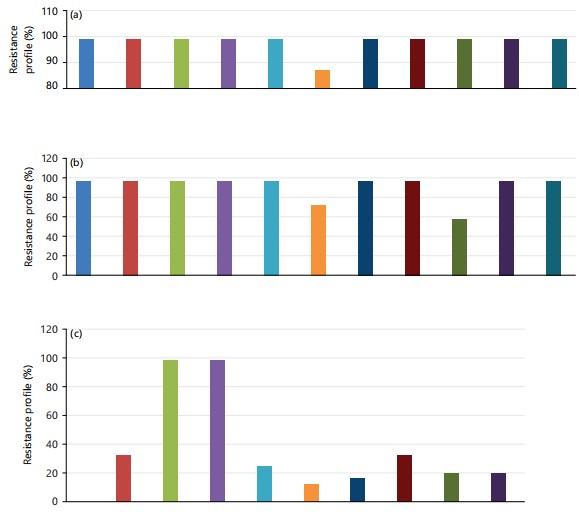 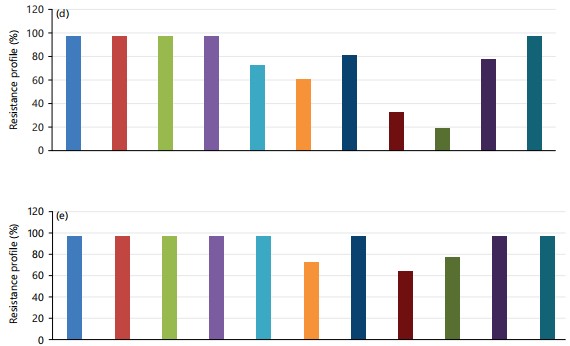 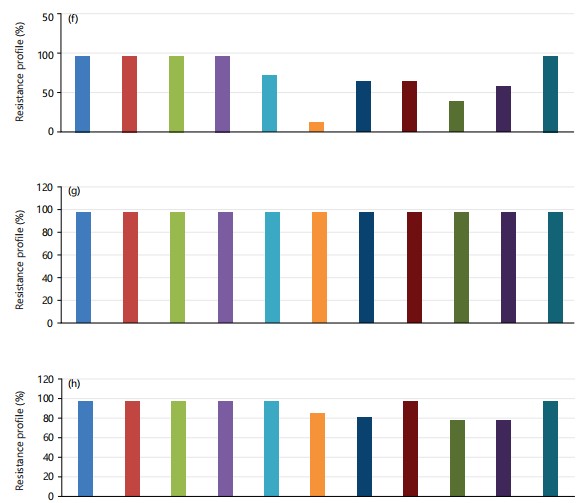 
|
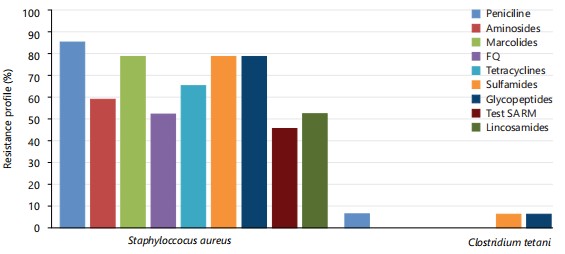
|
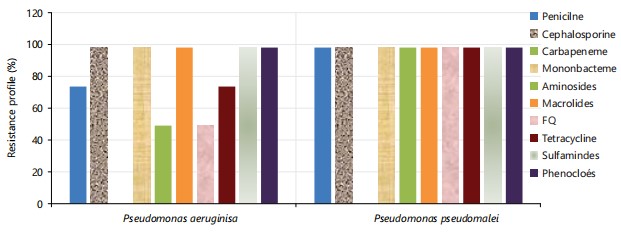
|
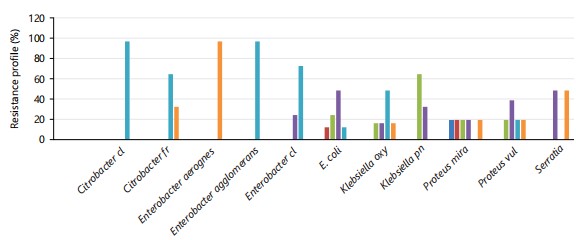
|
Figure 7 shows the multi-resistant profile of Pseudomonas. It appears from the analysis of Fig. 7 that all identified Pseudomonas species were resistant to at least 5 families of antibiotics.
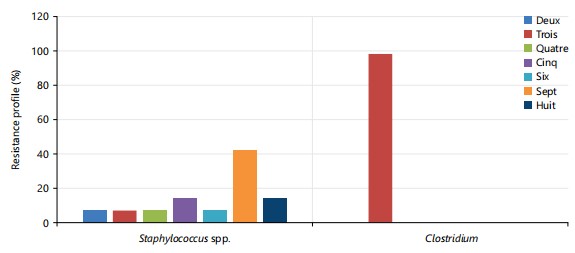
|

|
DISCUSSION
This study was aimed at determining the prevalence and antibiotic resistance profile of bacteria isolated from patients’ pus at the Bafoussam Regional Hospital. This study represents the first published data analysis on the prevalence and antibiotic resistance profile of bacteria isolated from patients’ pus at the Bafoussam Regional Hospital.
The overall prevalence of bacterial infection reported in this study was 89.40%. Males carried the highest number of bacteria, as well as persons aged 31-50 years. These results were similar to those of Obi2 where male patients were found to have more wound specimens (35) and bacteria isolates (67.9%) than females. According to Obi2, this could be due to the risk-taking nature of men both as young people and adults, especially when functioning as breadwinners of the family. Men could be more adventurous and attractive in physical activities, thus being more exposed to the various agents that can cause wounds and infections than their female counterparts. This could be explained by the fact that male patients in this age group are the most exposed age group due to their job specifications.
Analysis of comorbidities revealed that people suffering from neuropathy were the most affected by enterobacteria infections. Forster et al.3 had earlier reported similar results when they performed a cross-sectional analysis of the urine microbiome of children with neuropathic bladders. This could be explained by low mobility and hygienic measures not respected in these patients who no longer had the full capacity to take care of themselves. Wounds resulting from surgery, burns and accidents carried Enterobacteriaceae with a prevalence of 19.69, 10.6 and 28.78%, respectively. These results were in contradiction with those of Obi2 where Wounds from burns had the highest number of isolates but incidentally had the least number of clinical specimens collected.
Regarding the type of wounds, most of the isolated bacteria came from superficial pus. This result corroborated the observations of Puca et al.12 who determined the bacteriological profile of diabetic foot ulcers. This could be explained by the proximity of this type of wound to the environment unlike deep wounds13.
With respect to isolated bacterial strains, Enterobacteriaceae constituted more than half of the bacteria, followed by Gram-positive cocci (exclusively S. aureus) at nearly 24% and Pseudomonas species at 8%. These results were similar to those obtained by Evans et al.13 where S. aureus was the most frequently isolated microorganism from pus caused by an incision to reach the collection of pus or fluid under the skin surface and from wound types. The results contradicted those of Manikandan and Amsath14 where Pseudomonas aeruginosa (43%) was the most common followed by Staphylococcus aureus (24.3%). According to Lowy15 S. aureus is both a human skin commensal and frequently causes clinical bacterial infections such as boils, styes, pustules, impetigo, wound infection (cross infections) and osteomyelitis. This may be explained in all wound specimens collected. A generally high resistance rate was observed in Enterobacteriaceae against different families of antibiotics tested. Except for carbapenems, which had an efficacy of nearly 77%. These results are consistent with those of Matloko et al.16 who had demonstrated a low sensitivity of Enterobacteriaceae to amoxicillin and amoxicillin + clavulanic acid (that is, less than 30%) belonging to the penicillin family, but also a low sensitivity of 15% for third-generation cephalosporins. Also, Ionescu et al.17 isolated surgical site infections from bacteria, 29.23% of which were Enterobacteriaceae with a susceptibility rate to imipenem of 100%. This could be explained by the restricted accessibility of the population to this family of antibiotics due to the high cost of these molecules and regulatory restriction policies; however, compliance with the recommendations for the proper use of this family of antibiotics should not be neglected18. Fifty percent of the Staphylococci isolates were resistant to methicillin, the penicillin class showed 93% resistance to Staphylococci. This was consistent with the results of Abdoulaye et al.19 where they had a resistance of 88.6 and 83% to penicillin G and oxacillin, respectively.
This study shows that 96% of the bacteria that cause suppuration of the various wounds were multi-resistant. This percentage is much higher than that of Teklu et al.20, who had 56% multiresistant Enterobacteriaceae in the pus samples. This difference could be related to the divergence in the study population as well as the difference in the specific bacterial species studied.
CONCLUSION
The results obtained indicate high rates of resistance of multiresistant bacteria in pus samples. The frequency of isolation shows that Enterobacteriaceae are the most implicated species, followed by Staphylococci. Therefore, it is important to improve antibiotic prophylaxis protocols and probabilistic antibiotic therapy in the context of wound suppuration and to identify resistance genes produced by these germs.
SIGNIFICANCE STATEMENT
The emergence of multi-resistant bacteria is a problem in the surgery and diabetes departments of the Bafoussam Regional Hospital. It is therefore important to carry out a study to detect the genes responsible for resistance in bacteria isolated from different pus. The overall prevalence of bacterial infection reported in this study was 89.40%.
REFERENCES
- Merli, M., C. Lucidi, V.D. Gregorio, M. Falcone and V. Giannelli et al., 2015. The spread of multi drug resistant infections is leading to an increase in the empirical antibiotic treatment failure in cirrhosis: A prospective survey. PLoS ONE, 10.
- Obi, C.N., 2015. Isolation and sensitivity pattern of bacterial isolates of wound infections from patients of Federal Medical Centre, Umuahia, Abia State. Int. J. Curr. Microbiol. Appl. Sci., 4: 371-379.
- Forster, C.S., K. Panchapakesan, C. Stroud, P. Banerjee, H. Gordish-Dressman and M.H. Hsieh, 2020. A cross-sectional analysis of the urine microbiome of children with neuropathic bladders. J. Pediatr. Urol., 16: 593.E1-593.E8.
- Otta, S., N.K. Debata and S. Bichitrananda, 2019. Bacteriological profile of diabetic foot ulcers. CHRISMED J. Health Res., 6: 7-11.
- Schaller, M., 2022. Other Bacterial Infections of the Skin. In: Braun-Falco´s Dermatology, Plewig, G., L. French, T. Ruzicka, R. Kaufmann and M. Hertl (Eds.), Springer, Berlin, Heidelberg, ISBN: 978-3-662-63709-8, pp: 175-201.
- Verma, P., 2012. A study on isolation of different type of bacteria from pus. Int. J. Pharm. Life Sci., 3: 2107-2110.
- Tsatedem, F.A., J. Fondop, A.D. Bayol, J.H. Donfack and J. Djokam et al., 2023. Bacteriological profile of surgical site infection: A descriptive study at Deido District Hospital in Douala, Cameroon. Adv. Res., 24: 30-38.
- Vartoukian, S.R., R.M. Palmer and W.G. Wade, 2010. Strategies for culture of 'unculturable' bacteria. FEMS Microbiol. Lett., 309: 1-7.
- Grisez, L., R. Ceusters and F. Ollevier, 1991. The use of API 20E for the identification of Vibrio anguillarum and V. ordalii. J. Fish Dis., 14: 359-365.
- Buzón-Durán, L., R. Capita and C. Alonso-Calleja, 2018. Antibiotic susceptibility of methicillin-resistant staphylococci (MRS) of food origin: A comparison of agar disc diffusion method and a commercially available miniaturized test. Food Microbiol., 72: 220-224.
- MSFMAC, 2003. Antibiogram committee of the French society of microbiology report 2003 [In French]. Int. J. Antimicrob. Agents, 21: 364-391.
- Puca, V., R.Z. Marulli, R. Grande, I. Vitale and A. Niro et al., 2021. Microbial species isolated from infected wounds and antimicrobial resistance analysis: Data emerging from a three-years retrospective study. Antibiotics, 10.
- Evans, N.D., R.O.C. Oreffo, E. Healy, P.J. Thurner and Y.H. Man, 2013. Epithelial mechanobiology, skin wound healing, and the stem cell niche. J. Mech. Behav. Biomed. Mater., 28: 397-409.
- Manikandan, C. and A. Amsath, 2013. Antibiotic susceptibility of bacterial strains isolated from wound infection patients in Pattukkottai, Tamilnadu, India. Int. J. Curr. Microbiol. Appl. Sci., 2: 195-203.
- Lowy, F.D., 1998. Staphylococcus aureus infections. N. Engl. J. Med., 339: 520-532.
- Matloko, K., J. Fri, T.P. Ateba, L.G. Molale-Tom and C.N. Ateba, 2021. Evidence of potentially unrelated AmpC beta-lactamase producing Enterobacteriaceae from cattle, cattle products and hospital environments commonly harboring the blaACC resistance determinant. PLoS ONE, 16.
- Ionescu, M.I., D.S. Neagoe, C. Chiorean, L. Dumitras and A. Rus, 2014. Carbapenem resistance in non-fermentative bacterial species and in Enterobacteriaceae isolates from hospitalized patients in different health-care settings. Med. Pharm. Rep., 87: 235-241.
- Gauzit, R., L. Gutmann, C. Brun-Buisson, V. Jarlier and B. Fantin, 2010. Guidelines for good practice of carbapenems. Antibiotiques, 12: 183-189.
- Abdoulaye, O., M.L.H. Amadou, O. Amadou, O. Adakal and H.M. Larwanou et al., 2018. Epidemiological and bacteriological features of surgical site infections (ISO) in the Division of Surgery at the Niamey National Hospital (HNN) [In French]. Pan Afr. Med. J., 31.
- Teklu, D.S., A.A. Negeri, M.H. Legese, T.L. Bedada, H.K. Woldemariam and K.D. Tullu, 2019. Extended-spectrum beta-lactamase production and multi-drug resistance among Enterobacteriaceae isolated in Addis Ababa, Ethiopia. Antimicrob. Resist. Infect. Control, 8.
How to Cite this paper?
APA-7 Style
Christelle Nadia,
N.A., Amadou,
A.M., Cédric,
Y., Alex Kevin,
T.D., Michel,
N. (2024). Prevalence and Antibiotic Resistance Profile of Bacteria Isolated from Patients Pus at the Bafoussam Regional Hospital, West Region, Cameroon. Research Journal of Microbiology, 19(1), 9-21. https://doi.org/10.3923/rjm.2024.09.21
ACS Style
Christelle Nadia,
N.A.; Amadou,
A.M.; Cédric,
Y.; Alex Kevin,
T.D.; Michel,
N. Prevalence and Antibiotic Resistance Profile of Bacteria Isolated from Patients Pus at the Bafoussam Regional Hospital, West Region, Cameroon. Res. J. Microbiol 2024, 19, 9-21. https://doi.org/10.3923/rjm.2024.09.21
AMA Style
Christelle Nadia
NA, Amadou
AM, Cédric
Y, Alex Kevin
TD, Michel
N. Prevalence and Antibiotic Resistance Profile of Bacteria Isolated from Patients Pus at the Bafoussam Regional Hospital, West Region, Cameroon. Research Journal of Microbiology. 2024; 19(1): 9-21. https://doi.org/10.3923/rjm.2024.09.21
Chicago/Turabian Style
Christelle Nadia, Noumedem, Anangmo, Apouamoun Moupe Amadou, Yamssi Cédric, Tako Djimefo Alex Kevin, and Noubom Michel.
2024. "Prevalence and Antibiotic Resistance Profile of Bacteria Isolated from Patients Pus at the Bafoussam Regional Hospital, West Region, Cameroon" Research Journal of Microbiology 19, no. 1: 9-21. https://doi.org/10.3923/rjm.2024.09.21

This work is licensed under a Creative Commons Attribution 4.0 International License.


